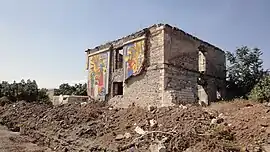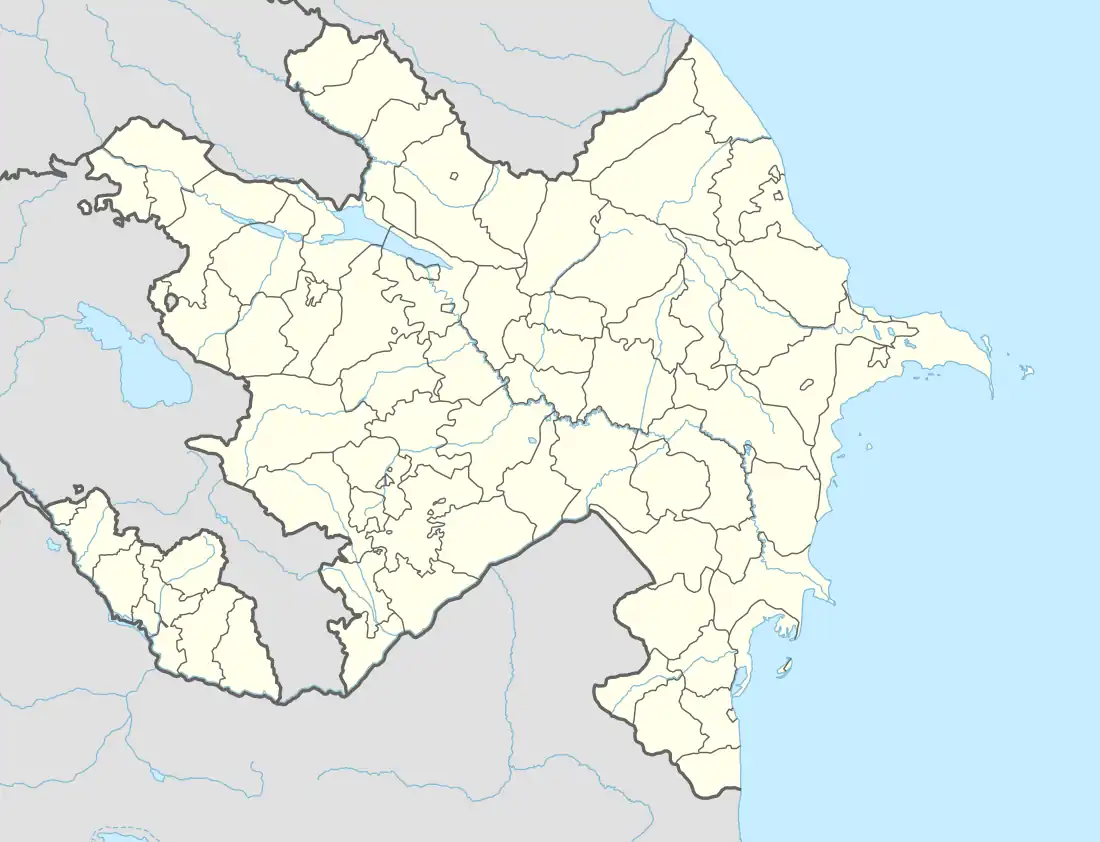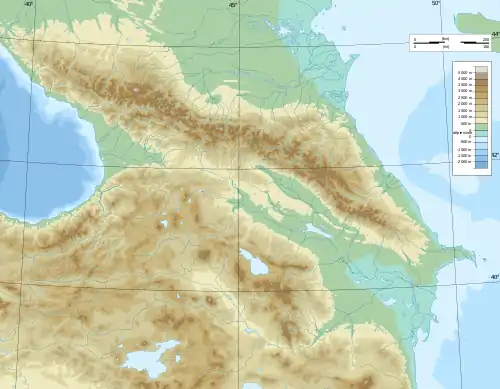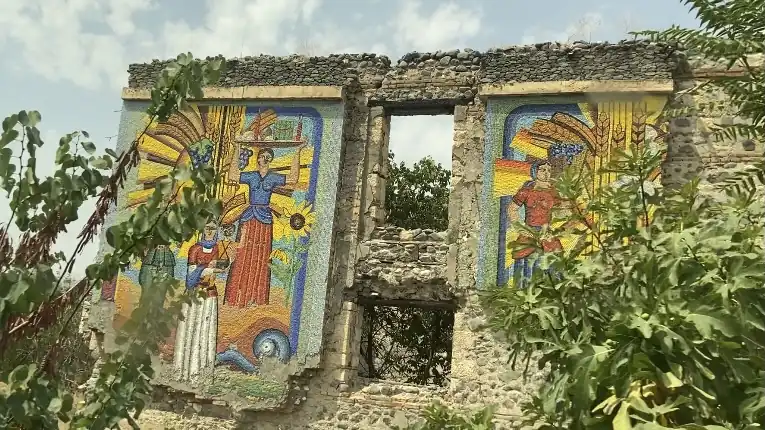Ağdam Çörək Muzeyi | |
 | |
 Location within Azerbaijan  Aghdam Bread Museum (Caucasus mountains) | |
| Established | 25 November 1983 |
|---|---|
| Dissolved | 12 August 1992 |
| Location | Aghdam, Azerbaijan |
| Coordinates | 39°59′30″N 46°55′54″E / 39.99167°N 46.93167°E |
| Collection size | 2800 |
| Director | Allahverdi Asadov (1983-1984) Ofelya Zeynalova (1984-1987) Niyazi Guliyev (1987-1988) Hafiz Aliyev (1988-1992) |
Aghdam Bread Museum is a designated museum of bread and bakery products, agricultural implements and their history being located in the Azerbaijani city of Aghdam.[1][2] The museum received its first visitors on 25 November 1983. It had about 2800 exhibits and was protected by state as a cultural monument. The "Sunbul" Cafe operated on the adjacent territory of the museum.[3] The complex also included a caravanserai.
As a result of the Armenian armed forces attacks during the First Karabakh War, several shells hit the museum twice. The first shell hit the third exhibition hall, but it did not explode, while the second one, fired from the direction of the Khanabad and Nakhchivanik villages of the Askeran district, on 12 August 1992, at around 16:40, put the end to the museum's existence. The attempts to extinguish the fire were unsuccessful and as a result, up to 1 500 exhibits were burned to ground.[4]
History
The initiative to create the Museum of Bread in Aghdam belongs to the first secretary of the regional committee of the Communist Party of the Azerbaijan SSR, Sadig Murtuzayev,[5][6] who in 1982 read an article about the Museum of Bread in the German city of Ulm in the "Izvestiya" newspaper. It was decided to create a Museum in the building of an old mill. The restoration work was carried out by local specialists. The main facade of the building was decorated with elegant stone shebeke and two huge mosaic panels almost two floors high. The idea of the mosaic belonged to Sadig Murtuzayev,[7] and it was made by the Aghdam artist-designer Zakir Rustamov. The panel was assembled using special colored stones.[8]
On 25 November 1983, the museum received its first visitors.[9][10] The mill, which housed the Museum of Bread, was built by Muhammed Garayev, a representative of a well-known family in the Aghdam district at the end of the 19th century. The museum was protected by state as a local cultural monument. The complex also included a caravanserai. In the Soviet occupation, the caravanserai on the territory of the so-called "Mill Yard" ("Dəyirman həyəti") was adapted for housing and leased to the local residents. In 1987, the mill was fully operational. The work on the museum's design was carried out by a group led by an employee of the Artistic Design Department of the Ministry of Culture, Eduard Krupkin. The delegation was chaired by the head of the Department of Museums, Sariya Ismayilova.[5]
The museum consisted of three main sections.[5] On its adjoining territory there was a cafe named "Sunbul", in which there was a tendirkhana (a room where bread was baked in a tendir).[3] The entrance opened directly into the summer hall. In the middle of the hall, part of which was covered, there was a small fountain. From here it was possible to go to Sunbul cafe, to the kitchen and to two small dining rooms. At the entrance to the hall, turning to the left, one could get into the exhibition hall. The museum also had a second entrance from where the road led to the administration building. The exhibition hall was high, sometimes divided into upper and lower tiers. Upstairs, on the left side of the entrance door, in the mezzanine compartment, there was an administration office with an area of 20 square meters, also and a foyer . From the foyer, there was a staircase to the attic of the museum, where spare exhibits were stored.[5]
The area of the first exhibition hall was 80 square meters, the second - 30. The first hall housed a mechanical mill capable of grinding 8-10 tons of grain per day. It also exhibited a used, in the 1930s, Trier machine for separating the grain from impurities. The second exhibition hall was also abounded with interesting exhibits: tools of labor - a plow, a threshing board, a knife, a sickle, a threshing machine - "charchar" ancient books, manuscripts and various materials testifying the development of the agricultural tools for grain growing and farming. On the wooden stairs to the right of the mill it was possible to climb to the second tier.[5] Flour products were also exhibited here, including types of bread baked in Ganja, Nakhchivan, Karabakh, Georgia, Armenia, Dagestan, Samarkand.[11] In addition, an ancient jug and kitchen utensils were displayed in the lower hall. The exhibits in the next hall were exclusively related to grain growing and agriculture. Various types of wheat, grains of different varieties, bread cards issued to children during the war, as well as a map of Azerbaijan made from wheat grains were exhibited here too.[5]
The walls of the museum were decorated with Azerbaijani proverbs such as: "When bread is expensive, death depreciates", "What a sword does not cut, the bread will", reminiscent of the power and sacredness of the bread.[12]
The "Natavan" girls' holiday,[13] the international festival "Khari Bulbul", held in the 1980s, began with a visit to the Museum of Bread.[7]
As a result of the attacks of the Armenian armed forces during the First Karabakh War, shells hit the museum twice. The first shell hit the third exhibition hall, but it did not explode. The second shell hit the museum on 12 August 1992, around 16:40. On this day, the city of Aghdam was subjected to a powerful rocket and artillery fire from the villages of Khanabad and Nakhchivanik of the Askeran district, due to which one of the rockets hit the Bread Museum.[14] It was that shell that put the end to the existence of the museum. There were attempts to put out the fire, but this was not possible.[5] The ceiling was made of wood and caught fire very quickly. Within an hour, the museum turned into ashes, leaving only the walls of the mill. As a result, up to 1 500 exhibits burned down.[4][7]
 Museum after Armenian occupation.
Museum after Armenian occupation.
In 2004, the staff of the Foundation for the Protection of the Word addressed the Minister of Culture and Tourism of Azerbaijan, Abulfaz Garayev, regarding the restoration of the Bread Museum in Aghdam.[15]
Exhibits
The Museum exhibited more than 300 samples of bread baked in the capitals of the republics of the former USSR. The Academician Imam Mustafayev, Doctor of Economic Sciences, the Professor Abulfaz Gasimov and many other representatives of the intelligentsia played an exceptional role in creating the exhibit fund of the museum.[3][16] During those years, the museum collected samples of bread from all regions of the Azerbaijan SSR. 16 ancient agricultural implements from the Gadabay district were transferred to the exhibition fund of the museum.[3] Of a great value were the samples of bread that had been into space and then sent to the museum from Moscow's Star City.[17]
Of a greatest interest, there was the most ancient exhibit of the museum - petrified wheat grains of the 7th millennium BC. These grains, discovered during the excavations on the Chalagan-tepe hill in the Aghdam village of Efetli, thanks to the efforts of the famous archaeologist Ideal Narimanov, were transferred to the museum by the academician, the breeder scientist Imam Mustafayev, the creator of the durum wheat. Subsequently, when Aghdam was under the threat of imminent occupation by the armed forces of Armenia, some exhibits were taken out of the museum, including these ancient petrified wheat grains. They were handed over by the head of the Department of Culture, Chimnaz Aliyeva, to the State Museum of History of Azerbaijan in Baku.[5]
As an exhibit, the Museum of Bread was also given a chaise, with which the local chaise maker Bakhman participated in all the festivities held in the 1980s in Aghdam.[7]
Some of the exhibits were donated to the museum by guests. So, Galina Andreevna Kanaeva, a baker by profession, who survived the siege of Leningrad, presented the museum with the “siege bread”. This was a small 125-gram ration, which was issued during the World War II during the blockade.[18] Kanaeva kept this bread in the memory of those days. Having seen a TV show about the Bread Museum, she came to Aghdam and donated this bread ration to the museum.[11]
Another interesting exhibit was the hand-made millstones of the 17th century (Kir-kire). They were presented to the museum by the 87-year-old Ismayil Gafar oglu Mammadov from the village of Aghamaly.
Museum staff
The first director of the museum was the journalist Allahverdi Asadov.[3] On 1 September 1984, this post was taken by Niyazi Guliyev, the editor of the AzTV department. He did not work for long leaving his post due to health reasons. Then the head of the district branch of the society "Bilik" ("Knowledge") Ofeliya Zeynalova was appointed as director,[7] later Hafiz Aliyev was.[5] Two scientists, three guides and a miller worked at the museum.[3] The purpose of establishing a miller's staff unit was to keep the mill in working condition in order to be able to present the finished products to guests.[5]
In culture
In 2013, AzDimension, an Azerbaijani company, released the video game "Under Occupation: Aghdam", from the shooter's first-person, in which one can find the Bread Museum.[19]
References
- ↑ Gault, Matt. "Qarabag are exiled from their home but could shock the Champions League". www.theguardian.com. Archived from the original on 2018-03-17. Retrieved October 18, 2022.
- ↑ Bonnett, Alastair (2014). Off the Map: Lost Space, Feral Places and Invisible Cities and What They Tell Us About the World. Aurum Press. p. 360. Retrieved October 18, 2022.
- 1 2 3 4 5 6 "Bərəkətli Çörək muzeyləri". anl.az. Archived from the original on 2020-01-27. Retrieved October 18, 2022.
- 1 2 "Aghdam Bread Museum". armeniancrimes.com. Archived from the original on January 20, 2022. Retrieved October 18, 2022.
- 1 2 3 4 5 6 7 8 9 10 "Dünyada ikinci hesab edilən Ağdam Çörək Muzeyi". karabakh.tv. Archived from the original on 2019-03-21. Retrieved October 18, 2022.
- ↑ Laçın, Sultan. ""O vaxt mənə zarafatla "Qarabağın mədəniyyət naziri" deyirdilər..."". hafta.az. Archived from the original on 2016-03-05. Retrieved October 18, 2022.
- 1 2 3 4 5 "Külə dönmüş Çörək Muzeyi..." modern.az. Archived from the original on 2019-04-14. Retrieved October 18, 2022.
- ↑ "Ağdam Çörək Muzeyindəki panno". medianews.az. Archived from the original on 2021-06-28. Retrieved October 18, 2022.
- ↑ Oxana Bulanova. "Горькая история Музея хлеба в Агдаме" (in Russian). azerhistory.com. Archived from the original on January 21, 2022. Retrieved October 18, 2022.
- ↑ "Aghdam Bread Museum". Ministry of Culture Azerbaijan . September 29, 2020. Archived from the original on October 18, 2022. Retrieved October 18, 2022.
- 1 2 Sabir Rustamkhanli (2013). My Road of Life. Bloomington: AuthorHouseUK. p. 260-261. ISBN 978-1481791823.
- ↑ "Ağdam çörək muzeyi". tarix.info. Archived from the original on 2021-06-28. Retrieved October 18, 2022.
- ↑ CBC TV (January 20, 2021). ""Natəvan" qızlar bayramı" (in Azerbaijani). Youtube. Retrieved October 18, 2022.
- ↑ "Aghdam Bread Museum". Azerbaijan State News Agency. March 16, 2022. Archived from the original on March 16, 2022. Retrieved October 18, 2022.
- ↑ "Ağdam Çörək Muzeyinin bərpası təklif olunur". apa.az. Retrieved October 18, 2022.
- ↑ "Ağdam rayonu". www.armenianvandalism.az. Archived from the original on 2019-06-09. Retrieved October 18, 2022.
- ↑ ""Ağdam Çörək Muzeyi" – "Dəyərli yaddaş abidəsi"". www.anl.az. Retrieved October 18, 2022.
- ↑ "Aghdam Bread Museum". nayora.org. October 13, 2020. Archived from the original on January 26, 2022. Retrieved October 18, 2022.
- ↑ Gojiashvili, Nino. "Azerbaijan: Video Game Revisits Nagorno-Karabakh War". www.eurasianet.org. www.eurasianet.org. Archived from the original on 2018-06-23. Retrieved October 18, 2022.
{{cite web}}: CS1 maint: unfit URL (link)
External links
- Bread Museum 1980
- Bread Museum before the occupation
- Ağdamın çörək muzeyi işğaldan sonra / Museum of bread after the occupation / BAKU TV
- "Ağdam və mən"- ÇÖRƏK MUZEYİ -yeni veriliş / "Agdam and I" - BREAD MUSEUM - new program
- Ağdam Çörək muzeyinin ilk direktoru ilə birlikdə 30 il sonra iş yerinə yollandıq / Together with the first director of the Museum of Bread, we visited the museum 30 years later. AzTV